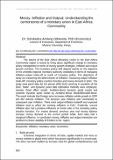Money, Inflation and Output: Understanding the cornerstones of a monetary union in East Africa Community
Abstract/
The advent of the East Africa Monetary Union in the East Africa
Community region is bound to bring about significant change in monetary
policy management in terms of money growth strategies, inflation and output
growth overtime. The monetary policy will depend mainly on the objective
of the umbrella regional monetary authority credibility in terms of managing
inflation-output trade-off as result of monetary policy. The objectives of
study are measuring the determinants of inflation, measuring output-inflation
trade-off, monetary policy reaction function and money demand in EAC. The
study used panel data for the period 1990-2010 covering 5 countries of the
EAC. Static and dynamic panel data estimation methods were employed,
namely: fixed effect model, Arellano-Bond dynamic panel model and
systemic dynamic panel model by Arellano-Bover Model/Blundell-Bond.
The result indicate that foreign price increases inflation while growth in GDP
and M2 reduces inflation. The previous year inflation also contributed to
subsequent year inflation. There exist output-inflation tradeoff and expected
inflation tend to affect the existing inflation in EAC. Evidently, current
inflation also had a positive influence on funds rates in the monetary policy
reaction function. For money demand, previous year real money balance
increase money demand in the current period while, fund rates had a
marginal influence. In conclusion money, inflation and output interaction are
pertinent to future stability of EAMU in the region.
Collections
- Department of Economics [104]

